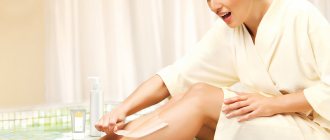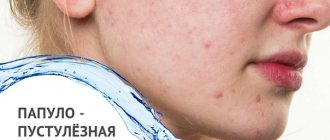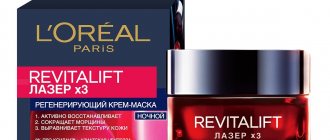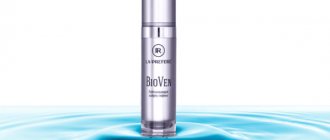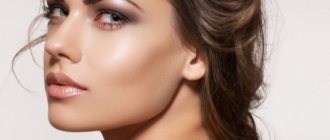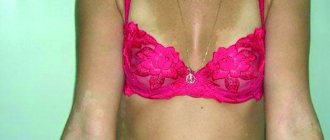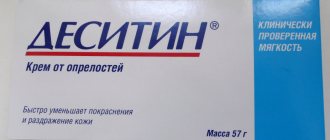A fungus that forms on the human body, affecting the skin or surface of the nail, is quite common. Ignoring such a disease leads to further damage to the nail plates on the feet or hands, as well as the spread of lesions to clean areas.
In order to fight this type of disease, there are a large number of medications in pharmacies that relieve the symptoms of the disease and eliminate its cause. One such drug is Terbinafine , which can be found in the form of a solution, tablets, or spray. But its most common forms are cream and ointment, due to its high efficiency and ease of use.
pharmachologic effect
An antifungal drug for external use with a wide spectrum of antifungal activity. In small concentrations, terbinafine has a fungicidal effect against dermatophytes (Trychophyton rubrum, Trychophyton mentagrophytes, Trychophyton verrucosum, Trychophyton violaceum, Trychophyton tonsurans, Microsporum canis, Epidermophyton floccosum), yeast fungi (mainly Candida albicans) and certain dimorphic fungi (Pityrosporum orbiculare).
Activity against yeast-like fungi, depending on their type, can be fungicidal or fungistatic.
Terbinafine does not affect the metabolism of hormones or other drugs.
The minimum inhibitory concentration for Trychophyton rubrum is 0.001-0.06 μg/ml. For onychomycosis of the hands, the effectiveness of treatment is 95%, for onychomycosis of the feet - more than 90%. With chronic dermatophytosis of smooth skin, remission is achieved in 75-95% of patients. Subjective improvement in the treatment of progressive candidiasis of smooth skin and lesions of large and interdigital folds, paronychia, caused by Candida albicans and resistant to therapy with nystatin, levorin in combination with clotrimazole and miconazole, occurs within 3-4 days, and complete resolution of the process occurs after 3-5 weeks
Terbinafine-MFF cream for external use 1% 15 g
Active substance
Terbinafine
pharmachologic effect
An antifungal agent for external use with a wide spectrum of antifungal activity. In small concentrations, terbinfine has a fungicidal effect on dermatophytes (Trychophyton Rubrum, Trichophyton Mentagrophytes, Trichophyton Verrucosum, Trichophyton Violaceum, Trichophyton Tonsuras, Micross Porum Canis, Epidermophyton Floccosum), mold (for example, Scopulariopsis Breviculis) and certain dimorphous mushrooms (Pityrosporum Orbiculare). Activity against yeast fungi, mainly Candida albicans, depending on their type, can be fungicidal or fungistatic.
Terbinafine specifically alters the early stage of sterol biosynthesis occurring in fungi. This leads to ergosterol deficiency and intracellular accumulation of squalene, which causes the death of the fungal cell. Terbinafine acts by inhibiting the enzyme squalene epoxidase located on the cell membrane of the fungus.
Terbinafine does not affect the isoenzymes of the cytochrome P450 system in humans and, accordingly, the metabolism of hormones or other drugs.
Indications
Prevention and treatment of fungal skin infections caused by sensitive pathogens, including mycosis of the feet (“fungus” of the foot), inguinal athlete’s foot (tinea cruris), fungal infections of the smooth skin of the body (tinea cruris), fungal infections of the smooth skin of the body (tinea corporus) caused by dermatophytes such as Trichophyton (including T. rubrum, T. mentagrophytes, T. verrucosum, T. violaceum), Microsporum canis and Epidermophyton floccosum; yeast infections of the skin, mainly those caused by the genus Candida (for example, Candida albicans), in particular diaper rash; Versicolor versicolor (Pityriasis versicolor), caused by Pityrosporum orbiculare (also known as Malassezia furfur).
Dosage regimen
Apply externally 1-2 times/day.
Adults and children over 12 years of age: Before applying the cream, the affected areas must be cleaned and dried. The cream is applied 1 or 2 times a day in a thin layer to the affected skin and adjacent areas and rubbed in lightly. For infections accompanied by diaper rash (under the mammary glands, in the spaces between the fingers, between the buttocks, in the groin area), the places where the cream is applied can be covered with gauze, especially at night.
Duration of treatment and frequency of use of the drug
Dermatomycosis of smooth skin and inguinal dermatomycosis (including dermatomycosis of the trunk, dermatomycosis of the legs): 1 week 2 times a day (morning and evening).
Ringworm of the feet: 1 week 2 times a day between the toes (morning and evening), 2 weeks 1 time a day (upper and lateral parts of the foot).
Fungal skin infections caused by yeast (cutaneous candidiasis): 1 week, 1 time per day.
Tinea versicolor: 2 weeks, 1 time per day.
If after 1-2 weeks of treatment there are no signs of improvement, the diagnosis should be verified.
Elderly patients (over 65 years old)
In elderly people, no dose adjustment is required.
Contraindications
Hypersensitivity to terbinafine or to any of the inactive ingredients included in the drug.
Carefully
Renal/liver failure, alcoholism, suppression of bone marrow hematopoiesis, tumors, metabolic diseases, occlusive vascular diseases of the extremities, pregnancy, breastfeeding, children under 12 years of age (lack of sufficient clinical experience of use).
Use during pregnancy and breastfeeding
In experimental studies, teratogenic properties of terbinafine were not identified. To date, no malformations have been reported with the use of Terbinafine cream. However, since clinical experience with the use of Terbinafine cream in pregnant women is very limited, it should be used only for strict indications.
Terbinafine is excreted in breast milk. However, if a nursing mother uses Terbinafine cream, a small amount of the active substance is absorbed through the skin, so adverse effects on the baby are unlikely.
The cream should not be applied to the mammary glands during breastfeeding.
During pregnancy and breastfeeding, use only if the expected benefit to the mother outweighs the potential risk to the fetus or child.
Cream
In cream form, the medicine for fungal infections is white. The structure of the drug is homogeneous and has a specific odor when applied. The 1% cream contains the active ingredient – terbinafine hydrochloride .
In the medicine, the ratio of the active substance to the volume of the finished substance is 10 mg per 1 g of finished product. In addition to this, the composition also includes:
- Petrolatum.
- Alcohol.
- Water.
- Glycerol.
- Triethanolamine.
- Stearic acid.
The product is produced in aluminum tubes, packed in cardboard packaging with instructions for use. Terbinafine in cream form can be purchased at pharmacies without a prescription from a medical professional.
special instructions
Irregular use or early termination of treatment increases the risk of relapse. If after 2 weeks of treatment there is no improvement in the condition, it is necessary to re-determine the causative agent of the disease and its sensitivity to the drug. During the treatment process, it is necessary to follow general hygiene rules to prevent reinfection (through underwear, shoes). Avoid contact with the mucous membrane of the eyes, nose, and mouth.
Impact on the ability to drive vehicles and operate machinery
During the period of treatment with the drug, it is possible to drive vehicles and engage in other potentially hazardous activities that require increased concentration and speed of psychomotor reactions.
Ointment
The drug is available in the form of a homogeneous white mass. The active substance is terbinafine hydrochloride .
In addition to the active ingredient, the composition includes:
- Propylene glycol.
- Sodium hydroxide.
- Methyl parahydroxybenzonate.
- Vaseline oil, water.
- Carbomer of polyacrylic acid.
But in the ointment the concentration of the active substance is higher, which makes it possible to more effectively combat damage to the skin and nails.
Directions for use and doses
Externally.
Adults and children over 12 years of age: apply the cream to the affected skin and adjacent areas in a thin layer, lightly rubbing, 1 or 2 times a day. The duration of treatment depends on the indication and severity of the disease. The course of treatment is on average 2-4 weeks. Duration and frequency of use: dermatomycosis of the trunk, legs, feet - 1 time per day for 1 week; skin candidiasis - 1-2 times a day for 1-2 weeks; lichen versicolor - 1-2 times a day for 2 weeks.
Terbinafine cream - instructions
Unlike ointment, cream does not penetrate so deeply into the skin. Part of the applied layer is often rubbed off on clothing and surfaces with which the affected area of the body comes into contact. Therefore, the use of cream can be increased up to 3 times a day.
The advantage of the cream is its effectiveness even on moderately wet surfaces, which is especially important for fungal skin infections. If it is not possible to dry the surface due to the constant release of liquid, it is better to buy a cream, since the ointment in this case will be ineffective.
What is the difference between terbinafine cream and ointment?
External forms of terbinafine are produced by Russian pharmaceutical enterprises Biosintez, MFF (Moscow Pharmaceutical Factory), Vertex (instructions), and Canon. In addition to ointments and creams, Terbinafine gel is on sale. In pharmacies you can find cream made in Belarus (Belmedpreparaty enterprise).
The concentration of terbinafine in all forms is the same - 1%, or 1 g per 100 g of the drug.
Cream and ointment are available in tubes of 15 and 30 g. Gel - 15 g.
Any of the forms is used to treat fungal skin diseases, namely:
- foot fungus,
- athlete's foot inguinal,
- fungal infections of smooth body skin: trichophytosis, rubromycosis, microsporia, including ringworm;
- pityriasis versicolor;
- yeast skin lesions, including diaper rash.
Apply the product 1-2 times a day to dry skin and rub in lightly. For extensive lesions, it is more convenient to use 30 g tubes. On average, treatment takes 1 week.
Terbinafine is less active against yeast, so it will take 2 weeks to get rid of the corresponding infection.
When applying any antifungal external drug, it is necessary to capture 1 cm from the affected area, in all directions.
The main difference between a cream and an ointment and a gel is in the composition of the formative base, more precisely, in the proportion of its fatty and water components. Based on the fat-water ratio, external preparations can be characterized as follows:
- The ointment base contains a lot of fat and little water. In this form, the drug is produced only by a couple of manufacturers, for example Terbinafine-MFF.
- In a cream, the water and fat bases are usually approximately equal. This is the most universal form and is produced by many pharmaceutical companies.
Terbinafine Vertex - The gel contains a lot of water and little fat base (Terbinafine Canon, Mikoferon).
Based on this, the use of dosage forms is somewhat different. The choice of dosage form is determined by the picture of the disease.
The fungus manifests itself in different ways: the skin can be dry, thickened or weeping. Often, the condition of the skin depends on the type of pathogen. Thus, naturally sweating areas of the body, where the skin is often damp (groin, armpits, under the breasts), are more suitable for infection with fungi of the genus epidermophyton. Cream or gel is preferable for weeping processes, when peeling and cracks are insignificant.
The ointment is used when the skin, on the contrary, is dry and needs moisturizing. For example, when foot fungus is accompanied by hyperkeratosis - thickening of the skin, keratinization and painful cracks, severe itching and flaking of the skin. In this case, ointment will be the best solution.
The gel delivers the medicine deep into the skin faster than other forms. It is lighter, absorbs quickly, and stains clothes less. It stays on damp skin better than cream, and even more so ointment.
Recommendations regarding the use of one form or another may be contradictory depending on the specific manufacturer of the drug. For example, Terbinafine cream produced by Belmedpreparaty has a dense and oily structure, more typical of an ointment. Its base contains a lot of fatty substances: wax, glycerin, sunflower oil. In addition, the cream contains urea. The latter component is known as a good moisturizer. In addition, urea is an excellent keratolytic that exfoliates dead skin particles. Thanks to this, the medicinal substance can penetrate deeper into the epidermis.
Domestic-made Terbinafine creams do not contain urea and their base is less fatty.
Another difference: ointment and cream can be used from 12 years of age, gel - only from 18 years of age. This difference is explained by the lack of sufficient clinical experience of use in pediatric patients.
conclusions
The amount of active substance in the forms of ointment and cream, as well as Terbinafine gel, is the same. The indications for use indicated in the instructions for the drugs are the same: for various dermatomycosis, a gel, cream or ointment can be prescribed. What will be more effective depends on the presence of weeping processes in the affected area of the skin. If the skin is dry, an ointment is suitable; if it is slightly wet, choose a cream or gel, but you should keep in mind the specific composition of a particular manufacturer. Therefore, you can replace one dosage form with another if the one you need is not available in the pharmacy
Terbinafine is an inexpensive antimycotic, but the cream and ointment are three times cheaper than the gel.
Terbinafine - side effects
Cream for external use Terbinafine is well tolerated by patients, even taking into account its synthetic components. Side effects from the use of the medicine, provided all medical prescriptions regarding the frequency of use and duration of therapy are followed, are minimized. However, it is not always possible to completely eliminate them. Among the main side effects that occur when using Terbinafine cream:
- allergic reactions;
- burning;
- itching;
- redness of the skin at the site of application of the drug.
How does it work?
According to its chemical structure, terbinafine belongs to the group of antimycotic allylamines. The target of allylamine drugs is the cell membrane of the fungus, which is based on ergosterol. With the participation of various enzymes, ergosterol is formed from another compound - squalene. Terbinafine blocks the enzyme squalene epoxidase, which is needed to convert squalene to ergosterol. Thus, the process of ergosterol formation stops. The membrane that protects the microorganism cell from external influences and maintains its internal state is destroyed. As a result, the fungal cell becomes vulnerable. In turn, “under-converted” squalene accumulates inside the cell itself, which has a toxic effect on the cellular organism, and it dies.
Terbinafine is active against:
- dermatophytes - trichophytons, epidermophytons and microsporum;
- mold fungi Candida ablicans, opportunistic microorganisms that, with abnormal growth, cause candidiasis (thrush);
- dimorphic fungi Pityrosporum orbiculare, responsible for the appearance of pityriasis versicolor (or versicolor);
- yeast fungi.
In the first three cases, the nature of the action is radical fungicidal, that is, microorganisms are destroyed. In the latter, it is fungistatic: the drug inhibits the growth of fungal cells.
Terbinafine has the ability to penetrate well into the skin and accumulate in all layers of the epidermis. At the same time, Terbinafine ointment differs from cream in that it remains in the affected area longer. The cream is absorbed faster. In any case, already 4 hours after application in the stratum corneum, the concentration of the substance significantly exceeds the minimum required to destroy pathogens.
The systemic effect of local forms of the drug is insignificant: no more than 5% of the active substance is absorbed into the bloodstream.
The more widely known antimycotic Lamisil is the same Terbinafine, only under a different brand name.
